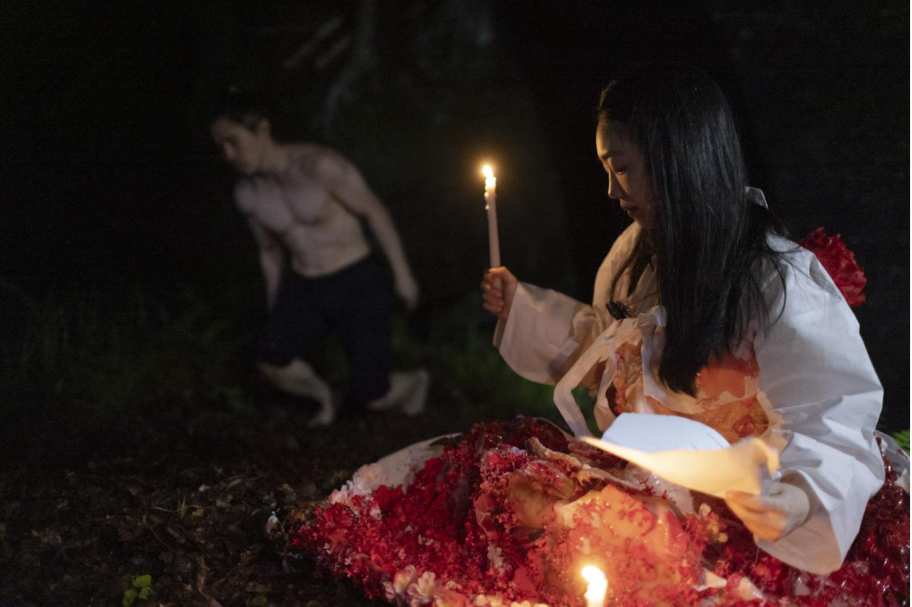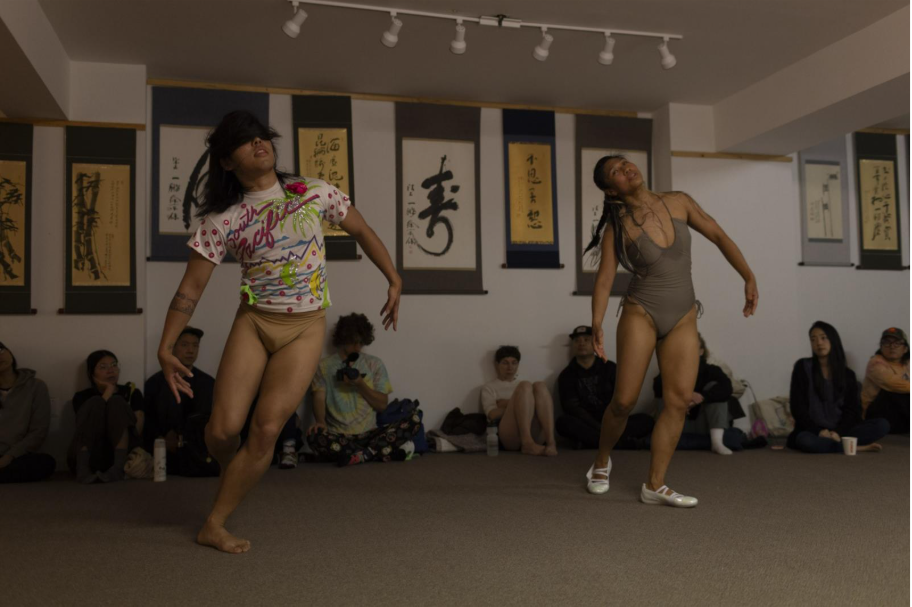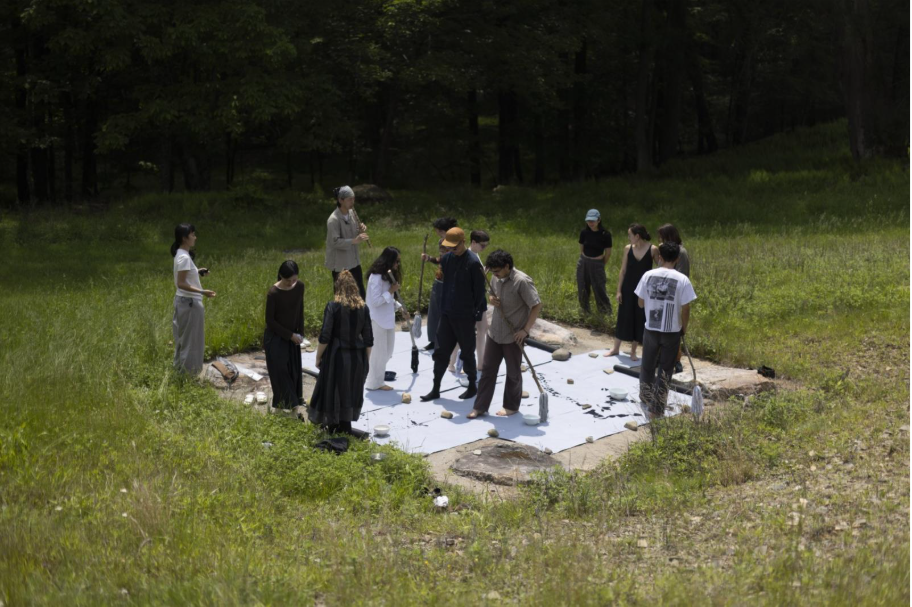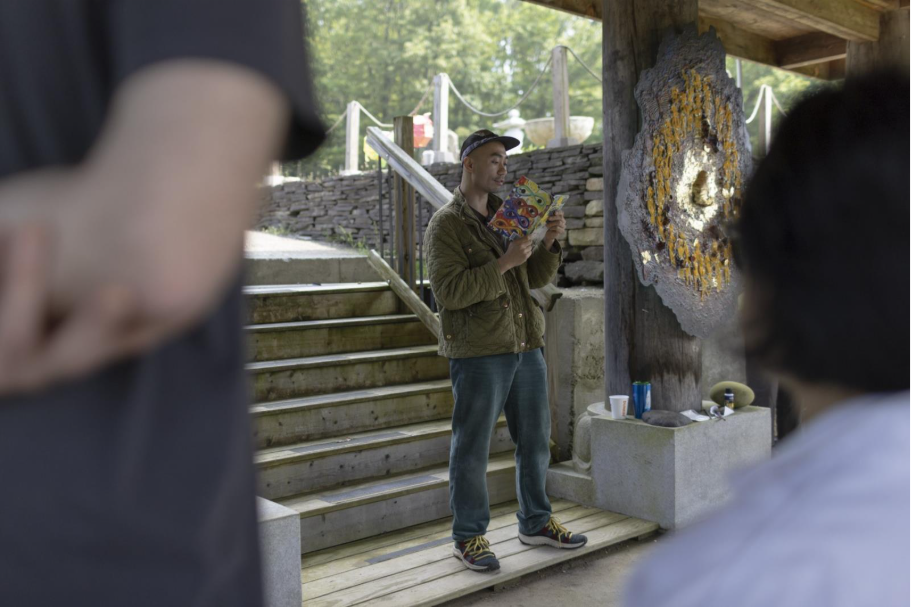Is This Thing Sacred? A Day of Art at Bak Lim Sa


Two dancers recite New Age affirmations as a Korean gong cymbal sends periodic reverberations through twenty participants encircling the performance. Anh Vo, in nude spandex and fluffy white kitten heels, squats across a golden Buddha and begins to twitch orgasmically. Fifteen minutes after marching back and forth in place with Kristel Baldoz, whose face pales with sweat, appearing like a victim of a horror film, the two dancers make ritualized, Sisyphean steps in clockwise revolutions, recalling orbiting planets, or hands on a clock. Words stream loosely, as if in and out of consciousness: “Beingness is nothingness is everything. I am empty but not dead. I am a hole for you to penetrate.” It is a citation of choreographer Sarah Michelsen’s 2012 Devotion Study #1 – The American Dancer, an almost 90-minute commentary on the sacrificial spirit of dance with elements of Hanoi avant-garde performance and Vietnamese oral shamanistic traditions culled from Vo’s research. The stage was the traditional Korean Buddhist Temple Bak Lim Sa during Sensory Cultivation, a 24-hour presentation of eight performances.
Framed as an experimental temple stay, this year’s presentation centered on improvisation and collaboration and took place between June 7-8, 2025. Hosted by Jon Santos, founder of the experimental platform Ontopo, and curated by Sofia Thieu D’Amico and Danni Shen, the performances played with the boundaries of Zen practice, rooted in its ethos of reciprocity, and of presence practiced through embodied attunement. The head monk’s mantra, “the work becomes the way,” foregrounded a spirit of critical not-knowingness and collective exploration of the unknown. Artists and participants, invited by word of mouth, held shared interests in alternative spaces and modes of working, as well as varying levels of relationships to the hosts and site.
Artist Anna Ting Möller elaborated on her kombucha-SCOBY practice in Smuggled like memory, a sound piece where she connected her kombucha offspring to modular synth cables and has a personal history of meditation retreats. In Thieu D’Amico’s words, “It was important to work with practitioners who would respond to the temple space and take something from it too,” though artists’ spiritual connections were not prerequisites.

Artist Grace Villamil’s field recordings Resonant Bells of the site’s sonic landscape mixed on a modular synth serendipitously developed into an improvisation with Rahul Nair and Woojae Kim, whose handmade percussion, inspired by research in Korean traditional instruments, took the form of the temple building. Artist duo AYDO (made up of Ayoung Yu and Nicholas Oh), who have previously performed site-specific installations and performances near the Korean DMZ and the US-Mexico borderland, led a lantern-making workshop and forest walk following an earlier barter session with ceramics and dreams titled Offerings. Jake Tobin’s untitled 15-minute sound collage of urban detritus meditated on the interconnectedness of the body and thinking mind.
Vo, following their performance, stated bluntly: “I’ve never had a reciprocal relationship working in visual arts spaces. They say, ‘Here’s the score. do it.’” Continuing, “we’re like set musicians.” Ontopo’s roots in presenting experimental music, besides overlapping the core practice of chant in the Jogye order of Korean Buddhism, intentionally unsettle the hierarchization of senses to destabilize gallery and museum presentations of performance, offering artist more open frameworks for their presentations. Developing a 20-year mutual relationship with the head monk, Santos programs performances at Ontopo that honor the interconnectedness of land and people, inspired by Hawaiian land division system ahupua’a. In turn, curators encouraged performances to emerge in response to the site, conscientiously maneuvering extractive relationships to spiritism, the occult, mysticism, and syncretic religion in arts practices, as much as the implications of larger spiritual appropriation that colonize devastated ecosystems and instate binaries wrought by individualist Western frameworks of Buddhist spiritualism.

Anchored in the relational tenets of Zen practice and alternative epistemologies, including Ursula LeGuin’s carrier bag theory and anthropologist Anna Tsing’s posthumanist forage for “disturbance-based ecologies” in our global condition of precarity, Sensory Cultivation rested in a non-dogmatic, non-ideological suspension of belief — a “no-mind” state to deepen unfolding relationships with one another, healing modalities, and creative practices. Though artists’ personal relationships to Buddhism, shamanism, or meditation practices were latent revelations, the (“encouraged, but optional”) 108 bows led at six am by a monk paralleled the ritualized and ritualistic gestures, palpable intensities of physical and embodied practice, and durational presence manifesting in the performances, blurring lines between spiritual and aesthetic experience.

Whereas performance presentations in white-walled exhibition spaces are undergirded by commodification and commercialization, necessarily priming audience performance and participation, we began the temple stay by sitting before the Buddha and resident monastics, introducing ourselves and mapping networked relationships while sitting on tatami mats. Meals were prepared and shared outdoors on long, stretching tables with temple staff. Ye Qin Zhu’s relief paintings installed under the gate temple invited participatory gold leafing over the 24 hours, and as Ching-Wei Wang (Way), Lu Gao, and Hancong Billy Chen handed off their brushes to us to simulate their shadow play, the intimacy of painting the peripheries of another’s body, taking care of another’s shadow, grounded the temple stay’s spirit of mutuality.
You Might Also Like
Magic and Optimism Closes The Immigrant Artist Biennial 2023
Editors’ Picks: Using Prose in Art and Dance to Address Social Justice
What's Your Reaction?
Lily Kwak is a writer and performance curator based in New York City. She holds a BA in comparative literature from Columbia University.

